OR/14/069 Preliminary findings: Difference between revisions
m 1 revision imported |
|
(No difference)
| |
Latest revision as of 15:41, 8 March 2016
| Bricker, S H, Yadav, S K, MacDonald, A M, Satyal, Y, Dixit, A, and Bell, R. 2014. Groundwater resilience Nepal: preliminary findings from a case study in the Middle Hills. British Geological Survey Internal Report, OR/14/069. |
Water usage
Community surveys indicate that springs are the main source of water in Ramche VDC, while in Madanpokara, springs sources are supplemented by shallow tubewells installed over the last 5–10 yrs. The tubewells are used predominantly for irrigation while the springs in both districts are used for domestic purposes. Many of the springs are perennial but with significantly lower flows reported by communities in the dry season (pre-monsoon) and water scarcity issues occurring in some localities as a result, e.g. insufficient water for irrigation in parts of Madanpokhara. Small concrete water storage tanks constructed alongside the springs and streams are important for maintaining supplies during dry periods. In Ramche VDC surplus water from larger spring sources is diverted to augment water supplies for smaller settlements with less reliable springs. Both communities believe re-afforestation around springs has an important role in sustaining reliable flows and protecting water sources.
Madanpokhara
The residents of Madanpokhara have access to both piped spring water and groundwater sources and some also have access to an established rainwater harvesting system. The majority of households in Madanpokhara also have electricity, sanitation facilities, and communication systems. Today 78% of villagers use drinking water piped to tap stands from springs. The VDC started using sprinklers for irrigation in the 1990s and rainwater harvesting and water-storing plastic ponds for irrigation have become common in recent years.
There are more than 250 small springs recorded in Madanpokhara VDC, though only ~50 of these are considered to be major sources for water supply purposes. In addition to the spring sources there are approximately 100 rainwater harvesting sites and 100 shallow tubewells installed in the last few years to support irrigation. The demand for water in Madanpokhara has increased as agriculture has grown and intensified. Community members in Madanpokhara stated that crop production has increased 10-fold in the last 10 years, and domestic use has also increased slightly. Individual water usage has not increased significantly but population has increased as they are attracted by the opportunity for commercial agriculture. Family sizes are also increasing. A shift in behaviour with people becoming more health conscious and with greater attention to cleanliness and sanitation may have led to an increase in water consumption.
There is anecdotal evidence of spring depletion and spring migration in Madanpokhara. After a decade of deforestation, 1962 to 1972, and anecdotal evidence of increased landslides and small spring sources drying up (Gyawali and Dixit, 1999[1]), households turned the situation around by beginning to conserve local forests.
Ramche
As with Madanpokhara, Ramche VDC has a large number of springs but only 15–20 of these are considered to be major sources for water supply purposes. Over the last 30 years a series of concrete water storage tanks, filled by spring and stream water and served to communities via pipes and taps, have been installed in Myagdi district. This method of water supply system continues to be implemented today with a current government initiative, coordinated at district level, to install further water supplies using storage tanks filled by small mountain streams. These new supplies are being installed to improve reliability and formalise the water supply systems rather than to address water scarcity. The schemes allow for 35 l/day/household and are managed by a water user community group. Tubewells are not being considered for Myagdi as it would be difficult to mobilise a drilling rig in the steep slopes and because electricity to power pumps is intermittent. The population in Ramche VDC is fairly steady, though farming is declining due to a reduced labour force. There has also been a shift towards potato and maize crops as they require less water and are easier to sell to nearby towns. The main concerns in Ramche VDC are declining spring discharge, increased pests, disease affecting the forest and water disputes, e.g. where not all wards are represented in the water user group.
Water use: Two water sources from each catchment were monitored monthly for three months in Madanpokhara and for four months in Ramche to understand water consumption pattern in the VDCs. In Madanpokhara two hand-pumps from ward number from 5 and 7 were selected to monitor the water consumption (Table 8). Water use was slightly less in late winter (January) and gradually increased to the early summer season (March) due to increasing demand in drinking and irrigation.
Chappani mul (Ward 5): Publicly owned hand-pump mostly used for sanitation. It is used by 10 households year round with an additional 5–10 households using it during the dry season. Average water consumption per household 107–215 l/day.
| Date | Water usage (litres) over 7 hours | ||||
| Drinking | Sanitation | Livestock feeding | Total | ||
| 4–Jan–14 | 400 | 1500 | 200 | 2100 | |
| 1–Feb–14 | 420 | 1600 | 250 | 2270 | |
| 1–Mar–14 | 450 | 1400 | 225 | 2075 | |
| Average | 423 | 1500 | 225 | 2148 | |
Damkada pump (Ward 7): Privately owned hand-pump used for domestic purposes and for irrigation for vegetable farming. It is used by one household only. Average water consumption per household 2170 l/day.
| Date | Water usage (litres) over 7 hours | ||||
| Drinking | Sanitation | Livestock feeding | Irrigation | Total | |
| 11–Jan–14 | 25 | 250 | 25 | 1500 | 1800 |
| 8–Feb–14 | 25 | 250 | 25 | 2000 | 2300 |
| 8–Mar–14 | 35 | 250 | 25 | 2100 | 2410 |
| Average | 28 | 250 | 25 | 1867 | 2170 |
In Ramche, two spring water sources were selected to monitor water consumption. Table 9 depicts the pattern of water consumption. Generally water from the source is used for domestic purpose and livestock feeding. For irrigation, water use was less in winter season (December and January) and gradually started to increase in late winter (February) and summer season (March). The water demand is increasing for drinking, irrigation and livestock feeding.
Seto Dhunga (Ward 2): Public spring source used by 6 households. Average water consumption per household 310 l/day.
| Date | Water usage (litres) over 7 hours | ||||||||
| Drinking | Cooking | Dish wash | Bathing | Washing cloths | Toilet and sanitation | Livestock feeding | Others | Total | |
| 14–Dec–13 | 90 | 120 | 360 | 100 | 160 | 120 | 800 | 10 | 1760 |
| 11–Jan–14 | 90 | 120 | 360 | 100 | 160 | 120 | 900 | 10 | 1860 |
| 8–Feb–14 | 120 | 120 | 360 | 120 | 160 | 120 | 900 | 10 | 1910 |
| 8–Mar–14 | 120 | 120 | 360 | 120 | 160 | 120 | 900 | 10 | 1910 |
| Average | 105 | 120 | 360 | 110 | 160 | 120 | 875 | 10 | 1860 |
Thulo Gaun Pandhera (Ward 4): Public spring source used by 3 households. Average water consumption per household 510 l/day.
| Date | Water usage (litres) over 7 hours | |||||
| Drinking, Cooking and Dish wash |
Bathing | Toilet and sanitation | Livestock feeding | Irrigation | Total | |
| 14–Dec–13 | 160 | 150 | 160 | 212 | 800 | 1482 |
| 11–Jan–14 | 160 | 150 | 160 | 222 | 800 | 1492 |
| 8–Feb–14 | 160 | 125 | 160 | 172 | 800 | 1417 |
| 8–Mar–14 | 160 | 225 | 160 | 182 | 1000 | 1727 |
| Average | 160 | 162.5 | 160 | 197 | 850 | 1529.5 |
Groundwater systems in the middle hills
Data analysis Spring flow measurements
Spring flow data for a full hydrological year (July 2013–June 2014) has been collected for four water supply springs in the Madanpokhara VDC and four water supply springs in Ramche VDC. Spring flows in Madanpokhara are generally lower possibly reflective of lower annual average rainfall totals and a smaller catchment area above the spring discharge points. The springs in all districts show a decline in spring discharge from high spring discharge during the monsoon season, declining during the post-monsoon season through to low spring discharge during the winter and pre-monsoon season (Table 10, Figures 26, 27, 28). The timing of spring flow decline varies between the different districts with typical spring recession starting during August–September in Nangi and during November in Ramche and Madanpokhara. Springs in all districts have winter and pre-monsoon flows of less than 1l/s. The rise in spring flow at Andheri Chharchare during the pre-monsoon season (Figure 28) is due to the introduction of an additional water pipe to the spring source to maintain sufficient water supply for downstream residential properties. Spring flows during the monsoon season tend to exhibit greater variability, this is especially so at Citeni in Ramche and Rato Jhapra in Nangi.
Further analysis of the spring flows is planned when more flow data become available and a year’s worth of stable isotope samples have been analysed.
Average spring flow (Litres per second) | ||||
| Monsoon (July–Sept) |
Post-monsoon (Oct–Nov) |
Winter (Dec–Feb) |
Pre-monsoon (March–June) | |
| Madanpokhara | ||||
| Baun Khola | 0.71 | 0.58 | 0.38 | 0.25 |
| Baad Khola | 0.29 | 0.27 | 0.24 | 0.05 |
| Andheri Chharchare | 0.26 | 0.27 | 0.08 | 0.05 |
| Nangi | ||||
| Rato Jhapra | 4.69 | 2.24 | 0.56 | - |
| Seto Kharsu | 1.46 | 0.76 | 0.18 | - |
| Ramche | ||||
| Thulo Mul | 0.43 | 0.27 | 0.17 | 0.14* |
| Citeni | 6.37 | 7 | 0.83 | 0.22* |
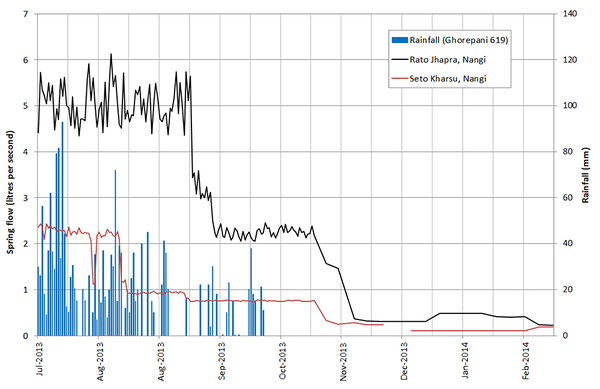
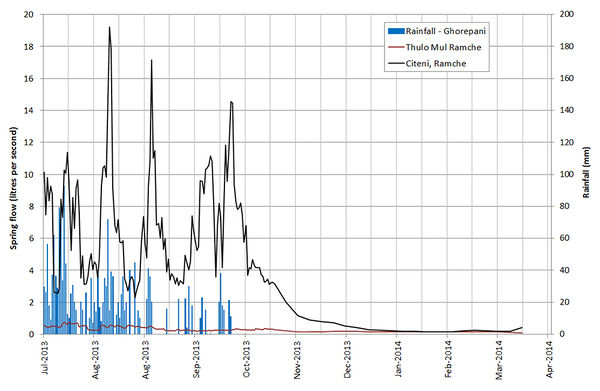
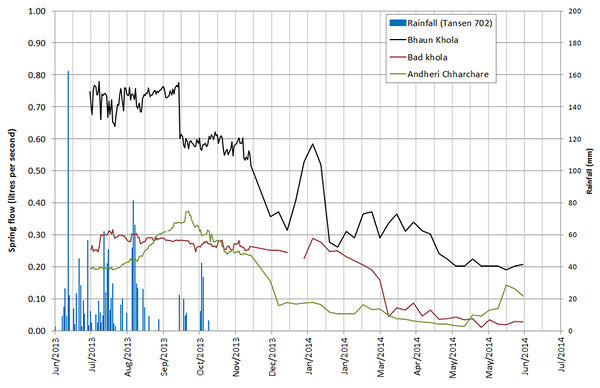
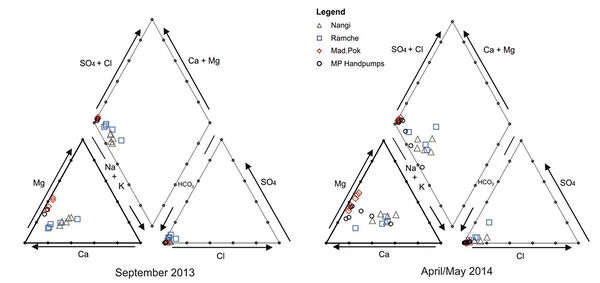
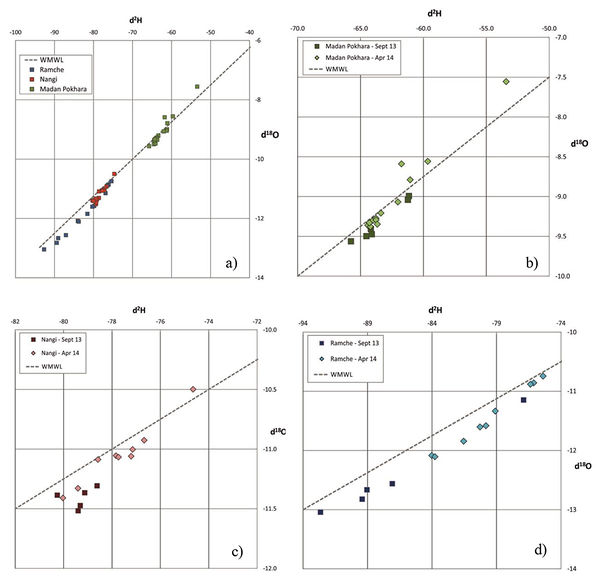
Groundwater chemistry
Major groundwater chemistry is shown in Figure 29. Groundwater sampled within Madanpokhara is dominated by the bicarbonate anion but a more complicated pattern emerges for the cations: springs are dominated by calcium and magnesium, consistent with a dolomitic geology; however hand pumps become increasingly dominated by sodium as samples are taken further into the floodplain, reflecting likely cation exchange. The groundwater chemistry of the handpumps in the floodplain also indicates reducing conditions with elevated iron and manganese concentrations and sulphate reduction. Comparatively high concentrations of arsenic and zinc are also detected in two of the handpumps drilled into the floodplain deposits. The groundwater chemistry of handpumps drilled at the margin of the floodplain at the base of foothills in Madanpokhara, is more akin to the chemistry of groundwater in an oxidised, unconfined aquifer setting with lower iron and manganese concentrations, and groundwater chemistry is generally similar to the spring water in the adjoining hills. Groundwater chemistry of springs in Nangi and Ramche is also dominated by bicarbonate, with no significant difference in chemistry between pre- and post-monsoon seasons. There is a suggestion that springs at lower elevations not located within the incised stream channels tend to have lower bicarbonate concentrations. In Ramche and Nangi, there is no dominant cation, with calcium, sodium and magnesium all generally present.
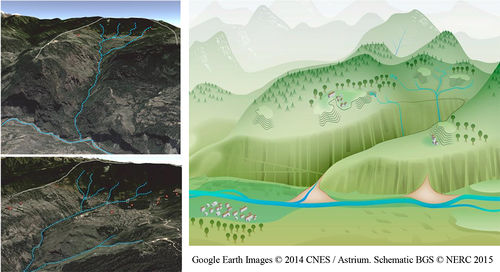
Only one groundwater chemistry sample was collected from the main river terrace deposits associated with the Kali Gandaki River at Beni. The chemistry results for this site show low dissolved oxygen concentrations perhaps due to a clay confining layer within the floodplain deposits. Despite the reducing conditions, iron and manganese concentration were not elevated. Comparatively high levels of Boron, Rubidium, Molybdenum, and Uranium, were detected which are indicative of a granitic geology within the catchment.
Groundwater age indicators (CFC, SF6)
Samples for CFC and SF6 were taken for both the pre and post monsoon sampling rounds. CFC concentrations tended to be over modern for the spring samples. Given the high altitude location of many of these springs, and their location with community forests, it is unlikely that all the over modern water is from contamination. It is more likely that the increased concentrations are due to the low temperatures, snow melt or turbulent flow processes. The SF6 data give more consistent results, and where the CFC data are from handpumps where the groundwater is not reducing, there is good agreement between the two. Therefore SF6 data are taken to be representative of the mean residence time (MRT) of the groundwater.
Preliminary interpretation of the data indicate that springs in Nangi and Ramche had consistently young mean residence times within 10–20 years: older groundwater tended to be from discrete springs and younger groundwater from more diffuse channels.
In Madanpokhora an interesting pattern emerges from the springs in the hillslope to boreholes in the floodplain. Groundwater from springs again appeared to have a mean residence time of approximately 10–20 years. The mean residence time at the edge of the floodplain close to the hillslope was within a similar range, although slightly older. Within the middle of the floodplain however, mean residence time increased significantly and was >50 years.
Stable isotopes
A trend of increasingly depleted δ18O and δ2H values with elevation is observed in the data (Figure 30), with sites in the Ramche and Nangi catchments, at elevations of 2200–2800 m asl, having more depleted O and H stable isotope values than Madanpokhara which occupies elevations of 500–700 m asl. This is consistent with local source of recharge to the springs.
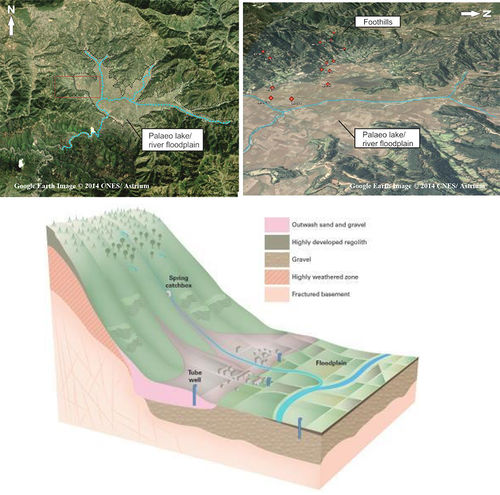
There are also differences in the stable isotope values between post-monsoon (Sept–13) and pre-monsoon (Apr–14) seasons for many of the sites within the Ramche and Nangi catchment, though the effect is most pronounced for sites in the higher catchment of Ramche (Figure 30). For the post monsoon samples, stable isotopes are more depleted, inferring a more elevated source for water sampled from the springs. This could be explained by springs having a significant surface water contribution in the monsoon season, which reduces throughout the winter as flow reduces and is sourced mainly from local groundwater. There are two exceptions: Thulo Mul (Ramche) and Rato Jhapra (Nangi) show little difference in stable isotope composition between the two seasons suggesting a more localised or more seasonally consistent groundwater capture zone.
Stable isotope results for the handpumps located in the floodplain deposits in Madanpokhara are different to the spring sources of the same catchment, with groundwater sampled from the handpumps having a more localised source than the springs. This may suggest that groundwater within the floodplain is distinct from groundwater within the weathered zone of the hillslopes. Handpumps located at the margin of the floodplain have stable isotope compositions more akin to the springs in Madanpokhara.
Hydrogeological conceptual models
Below we present a preliminary conceptualisation of the groundwater systems present within the Middle Hills of Nepal, based on the observation from the two field visits, and the preliminary interpretation of the data. Three distinct hydrogeological environments are identified: a) hillslope springs; b) palaeo-lakes and smaller river floodplains, and c) river terraces and outwash deposits in the valley floor of large river systems.
Groundwater in the hillslopes
Geographical setting: on the slopes of the Middle Hills, often near to or above the settlements on the valley sides, and valleys are drained by steep, deeply incised streams. Land use is a mixture of forest (either virgin forest or replanted after deforestation last century) and terraced agriculture.
Geology: Often thick, highly developed regolith and weathered bedrock zone overlying fractured basement comprising metamorphosed sandstones, gritstones and mudstones. Also poorly weathered rock exposures and areas of thin soil. There is negligible alluvium or any other superficial deposits.
Aquifer: Where present, regolith and thick weathered zone forms a productive shallow aquifer with high storage potential. The fractured bedrock provides a secondary aquifer with lower storage potential. The aquifer is recharged by snowmelt and monsoon rain; runoff is much greater where weathering is thinner. Where the weathered zone is thicker, there is significant storage and a greater potential for the retardation of groundwater flow paths.
Groundwater supplies. Groundwater discharge is almost exclusively through springs. These occur in two main types: as discrete issues at the base of a steep slope, or bowl; and more diffuse baseflow to deeply incised channels within weathered bedrock. Different seasonal variations and hydrological responses are observed for the two main spring types i) discrete springs tend to be less responsive with a more consistent spring flow during ISM and post-monsoon seasons though a reduction in springflow post-monsoon is noted at some sites, and ii) the diffuse springs, which tend to show large seasonal variations in spring flow throughout ISM season and post-monsoon season. Spring flows are typically perennial within the two study areas and minimum flow varies from approximately 0.3l/s–>6l/s, significant increases in spring flow occur during monsoon season.
Groundwater chemistry: The springs have bicarbonate groundwater chemistry, with no dominant cation, indicating some water-rock interaction and a carbonate geology. No significant water quality concerns were detected, though higher silt content during the monsoon is reported. Stable isotope results suggest that the capture zone for the diffuse high slope springs is from higher elevations with a larger catchment area during the monsoon season gradually decreasing in size with an increasingly localised capture zone during post-monsoon — winter — pre-monsoon. Stable isotope results for the discrete springs show less seasonal variation suggesting that springs at these lower elevations have a more seasonally consistent capture zone.
Resilience: Diffuse springs issuing from the higher slopes are reliant on recent monsoon rainfall and snow to sustain higher flows, but baseflows are sustained by groundwater storage within the weathered aquifer and will therefore have some inter-annual storage. Discrete springs issuing from the base of lower slopes are most likely to be fed from groundwater storage within the fractured aquifer network. The relatively weak coupling of springs to recent rainfall implies some inter-annual storage. Groundwater residence time indicators (CFC and SF6) suggest a mean residence time of 10–20 years for groundwater baseflow, implying again some in built resilience. However the general low storage of the groundwater environment suggests that none of the springs would be resilient to a long term reduction in precipitation.
The rapid decline in spring flows at many sites during the post-monsoon season suggests that much of the rainfall received during monsoon is discharged rapidly via the springs and incised stream channels. However the springs are perennial with groundwater storage in the weathered zone sufficient to support spring flow all year round. Groundwater age indicators (CFC and SF6) suggest that the mean residence time for groundwater issuing from the springs is of the order of 10–20 years. Stable isotope results for the diffuse springs in the higher slopes suggest that a reduction in precipitation or changes in the seasonality of rainfall would result in a more restricted groundwater capture zone for the springs and a lower year round flow. Stable isotope results for the lower discrete springs suggest a more localised but seasonally consistent groundwater capture zone. These springs may therefore be less vulnerable to changes in seasonal rainfall but may be susceptible to changes in the spatial rainfall patterns.
Spring flow and water quality are vulnerable to changes in land use, for example deforestation, landslides and increased development. Springs at higher elevations in the Middle Hills are generally well protected at present by the presence and preservation of community forest land use. Springs at lower elevations in close proximity to roads and dwellings and are susceptible to development which alters local drainage and which give rise to potentially polluting activities. Where springs are at a lower elevation compared with the village it is harder to supply the spring flow to houses under gravity feed.
In the higher catchments of the Middle Hills (Ramche and Nangi) the springs are sufficient to meet the requirements of the existing population and agricultural industries and there is no evidence that the populations are growing significantly. In the lower catchment (Madanpokhara) it is apparent that the springs are insufficient to meet current water demands for residential and agricultural use during the dry season and shallow tubewells are used to supplement supplies. The population of Madanpokhara is increasing as is the agricultural industry.
Geographical setting: Middle Hills, palaeo-glacial lakes and the active river valley floodplain. The floodplain is used intensively for agriculture. Residential properties are located around the margins of the floodplain and on the shallow foothills.
Geology: Glaciofluvial — lacustrine deposits and overlying floodplain deposits within a river floodplain setting. Alluvial fan deposits and terraces occur at the lake margin.
Aquifer:
- Floodplain deposits, comprising glacio-fluvial, fluvial and lacustrine sediments. Fine sands and gravels form the main aquifer unit. Within the Madanpokhara catchment there is evidence of a black clay deposit which acts as a confining layer for the aquifer. Artesian groundwater conditions primarily occur during the monsoon season. However artesian groundwater levels were observed at one tubewell towards the centre of the floodplain during the pre-monsoon season. The aquifer is likely to be recharged by direct rainfall, floodwater and through groundwater-surface water interaction where the aquifer is unconfined.
- Alluvial fan deposits and terraces at the lake margin, comprising outwash deposits, landslip materials and glacio-fluvial sand and gravel which form a high storage aquifer unit. The aquifer is likely to be recharged by direct rainfall and groundwater inflow from surrounding foothills.
Groundwater supplies: Shallow tubewells, fitted with handpumps and electric pumps, typically 20–30 m deep hand drilled into the floodplain deposits and within terraces/outwash deposits at the margin of the floodplain.
Groundwater chemistry:
- The floodplain deposits: form a confined aquifer with reducing conditions and sulphate reduction. Elevated iron and manganese concentrations are observed in several tubewells. Groundwater age indicators suggest a mean residence time of >50 years for the confined aquifer.
- Alluvial fan deposits: The groundwater chemistry from tubewells located within alluvial fan or terrace deposits at lake margin is of better quality and more akin to that of springs in the surrounding foothills. Iron and manganese concentrations are not elevated. Stable isotope results suggest a localised groundwater recharge area for these aquifers. Groundwater age indicators suggest a mean residence time in the region of 10–20 years.
Resilience: Shallow tubewells located within the floodplain are reliant on recharge from rainfall and recharge from river floodwater and river-aquifer groundwater exchange. The large groundwater storage available within the unconsolidated deposits increases the resilience of these water supplies. However, the reliance on hand drilling and the use of suction pumps (with a maximum lift of 7 m) will make these water supplies vulnerable to overexploitation.
River terraces and outwash deposits in the valley floor of large river systems
Geographical setting: Valley floor and river floodplain of principal rivers draining the Middle Hills e.g. Kali Gandaki river. The river floodplain is broader and less incised than the tributaries which drain the higher slopes. River terraces and alluvial fans are developed for both residential and agricultural land use.
Geology: River terrace sand and gravels associated with present day and former cold-climate rivers, known locally at ‘Tars’. The terraces deposits occur along most rivers in the Middle Hills and have a significant thickness in places. Alluvial fans, comprising glacio-fluvial outwash materials, occur at the confluence of tributaries draining the foothills with the wider river floodplains.
Aquifer:
- River terrace sand and gravels.
- Alluvial fan glacio-fluvial deposits. The aquifers are likely to be in hydraulic continuity with the rivers, with the terraces providing additional river bank storage. Terraces dissected by incised channels are likely to be well-drained with a more limited saturated thickness. The alluvial fan aquifers may also be recharged by groundwater draining the foothills.
Groundwater supplies: Potential for high yielding shallow tubewells and large diameter wells to supply small towns. The current groundwater usage in this geographical setting is thought to be low.
Groundwater chemistry: Very little data for the groundwater chemistry of the river terrace deposits and alluvial fans exists and only one large diameter well in Beni was sampled during the field investigations. Groundwater chemistry results from the large diameter well show comparatively high concentrations of Boron, Rubidium, Molybdenum and Uranium indicative of the granitic geology within the wider river catchment and is consistent with hydraulic connection between the river and groundwater within the terraces. Stable isotope results indicate that groundwater recharge to the terraces at Beni is derived from higher elevations within the catchment, rather than local recharge.
Resilience: Only one site could be investigated as part of this study. Theoretically, the supplies are likely to be resilient, given the storage available within the aquifer, and the abundant recharge from the river. However, the supplies have other vulnerabilities, such as contamination from activity on the floodplain, and erosion of the terraces.
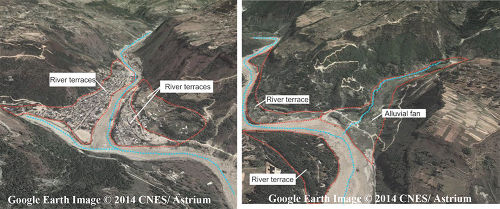
References
- ↑ GYAWALI, D, and DIXIT, A. 1999: Fractured Institutions and Physical Interdependence: Challenges to Local Water Management in the Tinau River Basin, Rethinking the Mosaic: Investigations into Local Water Management, Moench, M., Caspari, E. and Dixit, A. (eds.), pp.57–123, Nepal Water Conservation Foundation and Institute for Social and Environmental Transition, Kathmandu.